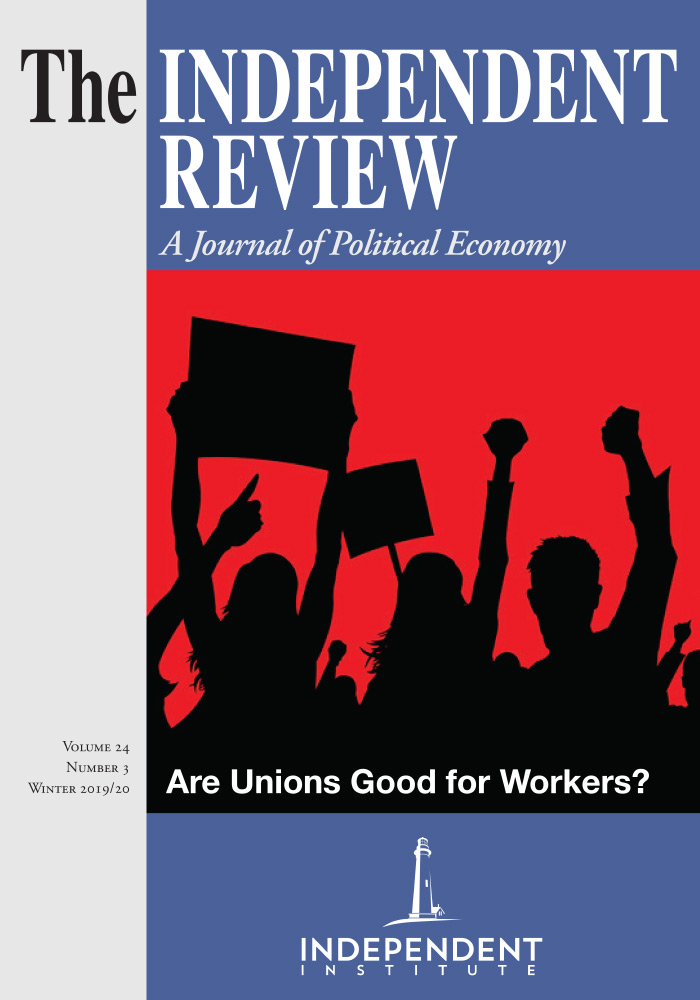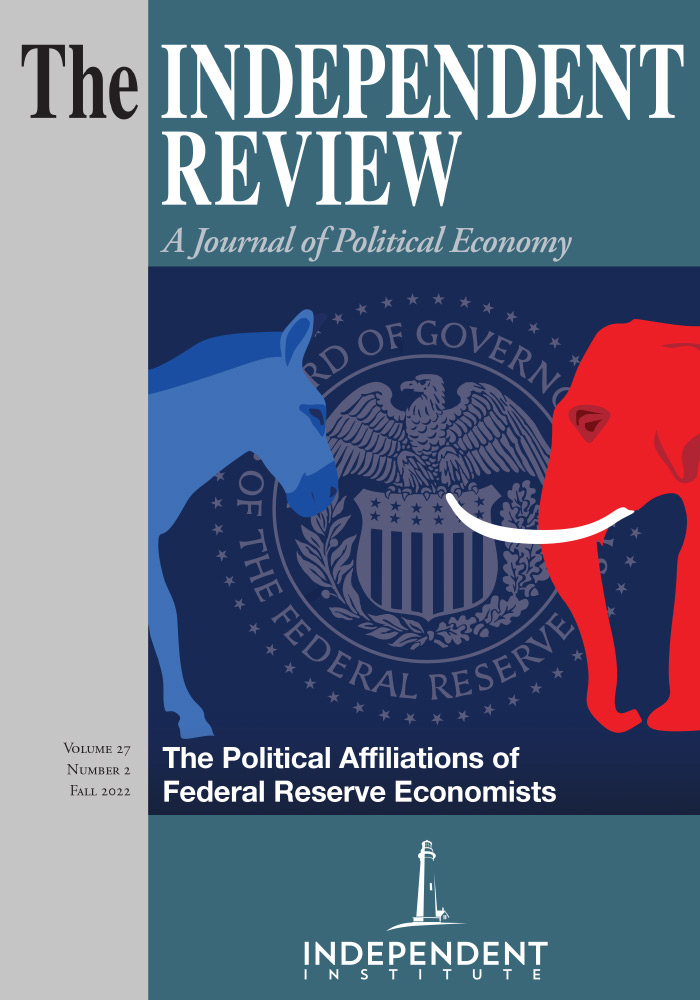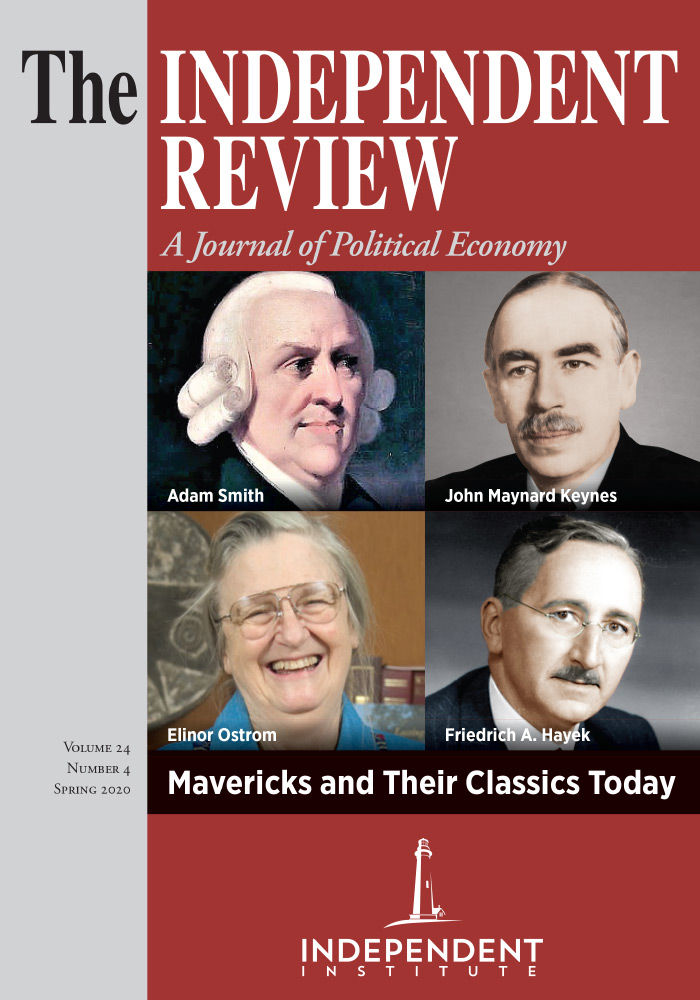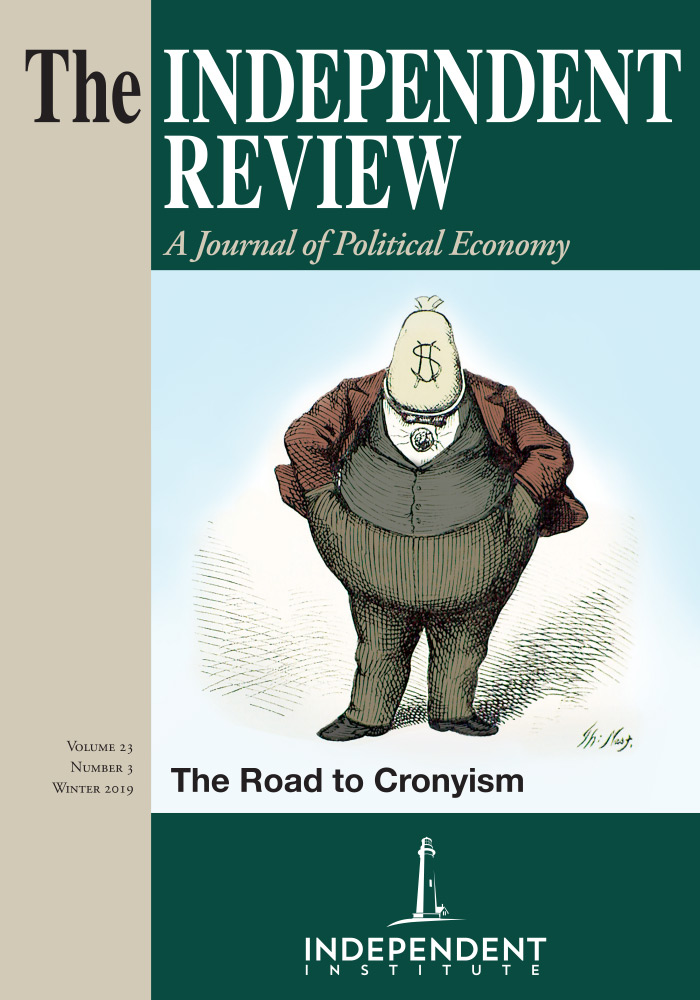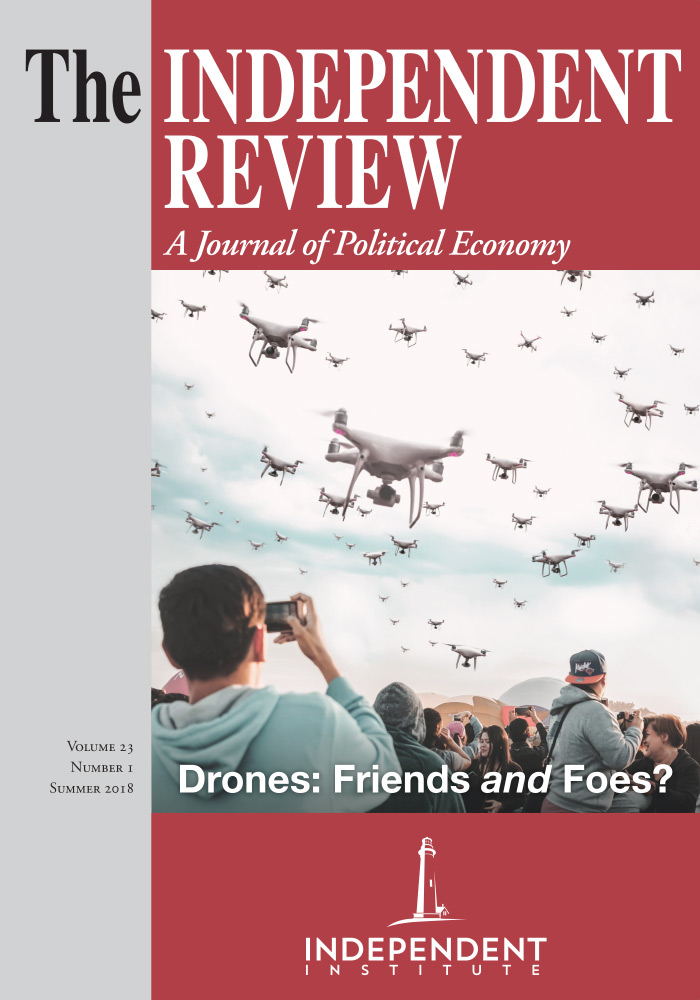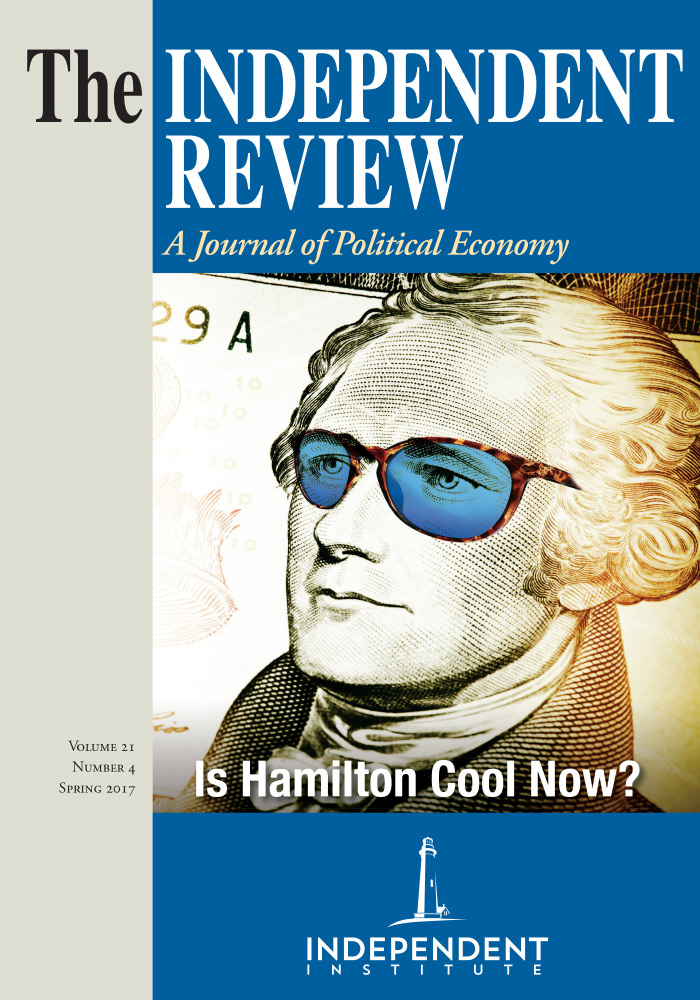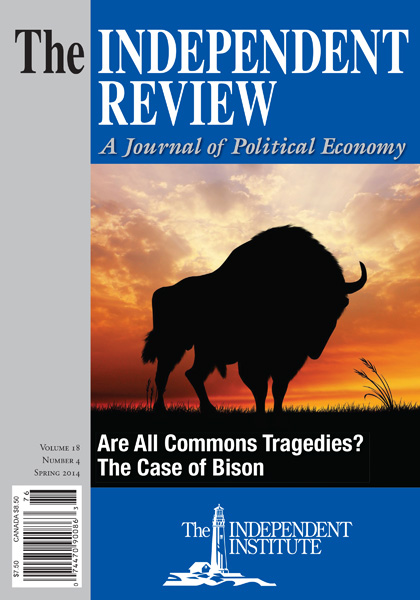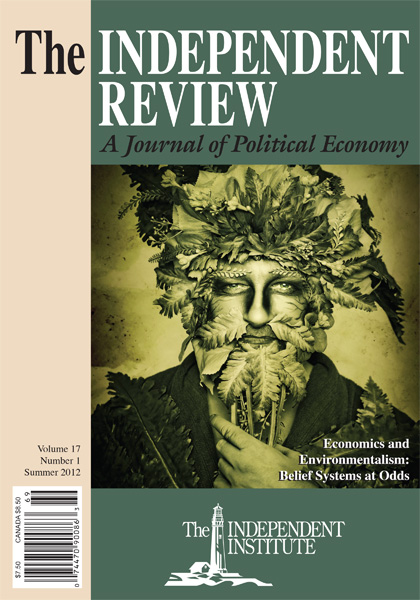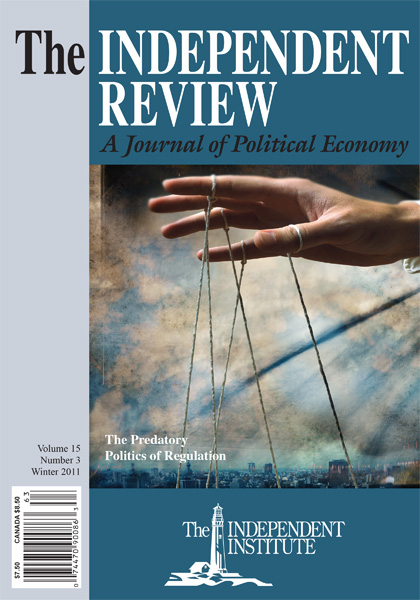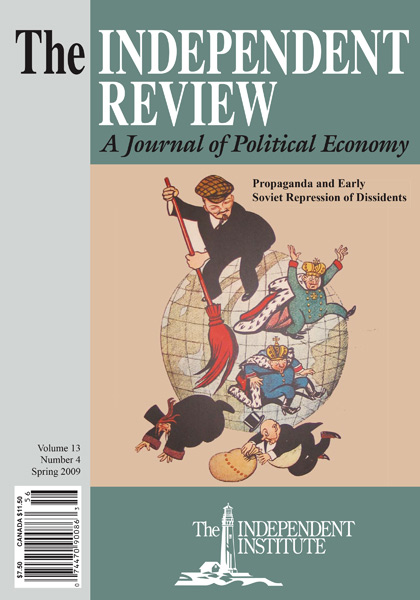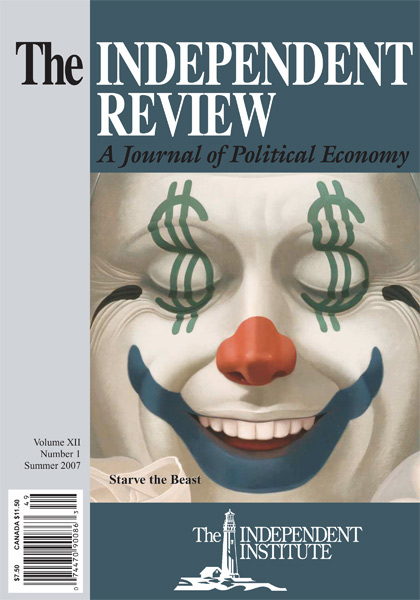Many Americans mistakenly believe that the “exploitation of labor” is inherent in the employer-employee relationship. Debunking this falsehood and other myths related to the role of labor unions is the first step toward understanding a sensible labor policy for the twenty-first century.
Article
Many Americans embrace fundamental misconceptions about the “exploitation of labor” that is supposedly inherent in the employment relationship and more generally about the role and background of labor unions in America. Economists, historians, and legal scholars have in the past undertaken thorough critiques of the American model of collective bargaining, and I do not purport to supplement—or even to summarize—that literature.[1] I do, however, hope to revive interest in a body of work that has tended to fade in the public consciousness. To that end, I discuss seven discrete aspects of the prevailing narrative that animates labor law. My thesis is that much of American labor policy is based on myths, which I endeavor to debunk.
The portion of the private-sector workforce in the United States represented by labor unions has steadily declined in recent decades. What, then, is the point of talking about unions?
For one thing, the subject is both vitally important and poorly understood. Labor relations necessarily requires exploration of first principles: What is the origin of “rights,” and how should individuals interact in a free society?On a more concrete level, “class” differences are embedded in modern political thought and animate much of the current progressive agenda. Many people reflexively believe that individual employees are “powerless” and “oppressed” and therefore need either collective action or external assistance (i.e., government intervention)—or both—to ensure fairness in the labor market. This type of thinking is behind many of the “living wage,” “guaranteed income,” and $15 per hour minimum wage proposals or behind even more radical proposals—the redistributionist agenda of “democratic socialism.”
Moreover, despite their declining membership in the private sector, unions have been—and remain—important forces in American life, both economically and politically. Labor unions—in both the private and public sectors—remain potent players in the political process, making endorsements, using members’ dues to support political candidates, providing manpower and infrastructure support (such as phone banks and membership communications) for “get out the vote” drives, and the like. They are among the largest contributors to political campaigns, with expenditures amounting to hundreds of millions of dollars each election cycle. Union members tend to vote at a higher rate among registered voters overall. For these reasons, organized labor wields considerable political clout. Unions are a powerful special-interest group and a major component of the Democratic Party’s electoral coalition.
Yet due to the decline in private-sector union membership, labor unions receive less attention from academics and public-policy think tanks than they did in the past. As a result, the subject of labor relations has largely receded from the spotlight. Despite its importance, the topic is increasingly overlooked in the nation’s colleges and even law schools. The power and influence of organized labor persist, even as public awareness of the subject continues to fade. Unlike other major interest groups in America, labor unions receive scant scholarly and media scrutiny. Many of the leading works in the field were written decades ago. The role and background of labor unions are rarely questioned. The conventional narrative, hearkening back to the New Deal, is simply assumed to be correct.
This is unfortunate. Understanding the background of the union movement in America requires some knowledge of neglected aspects of politics, economics, government, history, and law. One of the challenges in the area of labor law is to overcome the pro-union (or anticapitalist) bias that is prevalent among many labor-law scholars and labor historians (see Hayek [1954] 1963; Moreno 2008).[2] As written by progressive academics, the history of labor unions in America is as full of fiction as Aesop’s fables or the Grimm brothers fairy tales.[3] This article attempts to dispel some of those myths.
Terminology and Concepts
I proceed from the classical liberal premise that in the “state of nature” all people are born free and are endowed by their creator with self-ownership—that is, their labor and the direct fruits of their labor belong to them. The opposite of self-ownership is slavery, servitude, or serfdom. Self-ownership leads to recognition of the institution of private property. In a free society, one owns what one produces or acquires through consensual exchange. When entering into civil society, pursuant to a fictitious (but essential) social contract, people surrender some of their natural rights in exchange for the protection of laws. Our state and federal constitutions represent the terms of this “bargain.” These concepts are reflected in our Declaration of Independence and are consistent with the Lockean concepts that influenced the Founding Fathers.
In a society based on individual liberty, limited government, and the protection of private property, the ideal form of interaction among people is consensual economic exchanges, which protect personal freedom and maximize economic efficiency. Force and coercion are the opposite of voluntary actions. In a free society—as opposed to a centrally controlled (and therefore authoritarian) state—the only “entitlement” one has is the right to engage in consensual exchanges with willing participants on mutually acceptable terms. “Private ordering” in this fashion must be free of coercion, fraud, and predation. No one has a “right” to take another’s property, to compel transactions, or to force another to accept terms involuntarily. Any of these actions is simply unfair. Conversely, no one has the “right” to interfere with or prevent consensual exchanges by others on terms that are agreeable to them. This type of action, too, is simply unfair.
From an economic perspective, labor is like any other commodity bought and sold in the market (see Pulliam 1981). Wages are the price of labor, and in a free market they would be determined by a consensual exchange between buyer (employer) and seller (employee) as the result of competition. In a free society, an employment relationship must be between willing parties on terms acceptable to both, without fraud or coercion. The fairness of a particular transaction between an employer and an employee can be judged only by whether it was entered into voluntarily and without fraud or coercion.[4] Terms that are objectionable to one person may be acceptable to another. Such differences are inherent in competition.
What is a labor union? A union is not a social group or a fraternal organization, like the Rotary Club or Kiwanis Club. It is the collectivized agent of workers, organized to obtain higher wages and more favorable working conditions than workers could obtain on their own through competition and consensual exchange. How, exactly, does this happen? A union essentially operates as a cartel, fixing the price of its members’ labor by internal collusion rather than by market competition—just like members of the Organization of the Petroleum Exporting Countries (OPEC) work to increase the price of oil rather than letting the competitive market set the price. The internal price fixing for labor is called “collective bargaining.”
Like OPEC, a labor union threatens to withhold supply if the buyer does not agree to pay the “fixed” price. This withholding is called a “strike.” Unlike OPEC, however, a union attempts to prevent other sellers (who are not members of the cartel) from selling at a lower price, sometimes with the threat of violence. This is called a “picket line.” Strikers not only collectively withhold their own services (which is consensual) but also seek to prevent other workers from crossing the picket line (through force or coercion). Unions call these other workers “strike breakers” or “scabs,” but they are merely sellers willing to accept a lower wage—a function of competition and consensual exchange—which is entirely legitimate in a free society.
If OPEC countries tried to blockade shipping to the United States to prevent the delivery of oil from non-OPEC suppliers, we would quite properly regard this blockade as an act of aggression—even war. Among unionized workers, however, the same behavior is celebrated as “solidarity.”
Also, unions, unlike OPEC, depend on government coercion. Federal law requires employers to “recognize” unions once they are “elected” by a majority of the employees; requires employers to negotiate exclusively with the union before taking action regarding the employees; prohibits employers from firing employees because of their union involvement; and prohibits employers from replacing striking workers under certain circumstances. All of these requirements and prohibitions are significant restrictions on the common-law rights—and economic freedoms—enjoyed by employers prior to the enactment of federal labor laws beginning in 1935.
The reason we have labor unions—to establish what unionists euphemistically call “industrial democracy”—is purportedly to overcome the inherent “inequality of bargaining power” that is thought to exist between capital and labor. The legislative “findings” in support of the National Labor Relations Act (NLRA, also known as the Wagner Act) of 1935 so state. As will be seen, this controversial notion has dubious origins and has had far-reaching implications for labor law.
Myth Number 1: Inequality of Bargaining Power
In a competitive market, workers sell their services to employers at a wage rate that is determined by competition among both buyers and sellers. The specific wage bargain struck will depend on the worker’s perceived value to the employer and the existence of competing offers by other employers. In the world of free markets, the government’s main role is to punish fraud, enforce contracts, and prevent collusion. Labor unions, which exist to facilitate collusion among sellers, are unnecessary in a free society. Nothing inherent in labor markets prevents consensual arrangements between employers and individual employees on mutually agreeable terms. However, critics of freemarket economics have a different view—sometimes radically different.
Karl Marx is often credited as the intellectual father of modern socialism. Marx believed that capital (the owners of businesses) and labor (the workers employed by businesses) represent separate, antagonistic classes and that the employment relationship is inherently exploitative because workers in a capitalist society are forced to sell their labor power to capitalists for less than the full value of the commodities they produce with their labor. Capital’s ownership of the “means of production” allows business owners to extract the “full” value of workers’ labor (i.e., the price of the finished product) while paying them for only the “commodity” value of their services (i.e., an hourly wage rate). In this theory, the added value is assumed to belong to the workers, and the employers’ resulting profit is wholly undeserved. Marxist theory assumes that capital owners contribute nothing to the process of production.
From a Marxist perspective, profiting from capital is illegitimate—equivalent to stealing. By retaining the “surplus” value of workers’ labor, capital exploits the workers, an injustice that can be corrected only if the workers seize ownership of the businesses and therefore dispense with the parasitical role of capital. For Marx, class struggle, leading to revolution and seizure of the “means of production,” is the only way to prevent the exploitation of labor. Private-property ownership is therefore incompatible with Marxist theory. Employment by a profit-making business constitutes oppression. This extreme form of socialism is the foundation of communism. One can just imagine how militant workers would be if they sincerely believed Marxist rhetoric, as many did during the heyday of the Industrial Revolution. They were incited to revolt and overthrow the established order, by force if necessary.
In the late nineteenth century, as industrialism was burgeoning, Marx’s conception of socialism began to become associated in the public mind with violent anarchism—an unfavorable connection—leading nonrevolutionary socialists to embrace “kinder, gentler” versions of Marx’s theory, some of them predating Marx. This school of thought, symbolized by the Fabian Society in London (founded in 1884), became the basis for England’s Labour Party. Some of the prominent figures associated with “Fabian socialism” include Sidney and Beatrice Webb and, in the so-called second generation, Harold Laski.
Nonrevolutionary socialism, or “democratic socialism,” inspired much of twentieth-century labor-union theory. The more moderate brand of socialism did not call for outright worker ownership of the “means of production” but emphasized the need for concerted action by employees to rectify the purported “inequality of bargaining power” between labor and capital (sometimes blamed on capital’s ability to organize into corporate entities) and to exercise some control of the business through union negotiations. Empowering workers in this way would, it was thought, prevent capital from earning “excessive” profits. This is the genesis of the modern American labor-union movement and forms the gist of trade-union rhetoric even today.
Marx and his successors were dead wrong. It is a fallacy to ignore—or deny—the crucial role of capital in the creation of goods and services. Prior to industrialization and the division of labor in the form of specialized trades, nearly every man toiled on the land. If he owned the land outright, the crops he grew were his property. If he toiled on the land of another, he either paid rent or shared his crop with the owner. As trades developed, blacksmiths, cobblers, weavers, and the like either had the resources to acquire their own tools and supplies or had to rely on another to furnish these items—capital goods. In the former situation, he was his own master; in the latter, he was an apprentice or workman in the employ of another. The workman had to share the bounty of his labor with the provider of capital on terms agreeable to both. This is the conceptual origin of the modern employment relationship.
It is intellectually dishonest to skip from an agricultural economy to the factory system and deny the factory owner any credit for amassing the capital, devising the machines, and incurring the risk that made the enterprise possible.
In any event, is there an inherent inequality between labor and capital? The classical economic model shows otherwise. As long as there is competition among buyers and sellers as well as the absence of external coercion, the market-clearing wage will favor neither side—rather, both employers and employees will gain from the exchange. It doesn’t matter whether the buyer (employer) is an individual, sole proprietorship, partnership, or corporation. The principle is the same. Absent monopsony power—that is, domination of the market by a single buyer or small group of buyers—competition among employees and employers will yield the optimal result, and workers will be paid equal to the value of the marginal product of labor—that is, the value of the last unit they have produced for the employer.
The legal form of the buyer or seller is irrelevant. All that matters is the existence of competition among uncoerced market participants. Does an individual consumer have a disadvantage at Walmart or on Amazon as compared to in a Middle Eastern bazaar? Of course not. As a matter of economics, labor is a commodity, and the proclamation to the contrary in the Clayton Act of 1914 is simply a protectionist measure reciting the vernacular of socialist dogma. The conceptual basis for the trade-union movement rests on an empty political slogan.
Depending on the employee’s skill, experience, industry, and productivity, wage rates will vary across the workforce and across different industries. In today’s economy, without union representation some brand-new lawyers earn starting salaries approaching $200,000 per year; computer programmers can demand valuable stock options from the high-tech companies they work for; and welders and other trades in the oil patch earn in the six figures. Hollywood stars, professional athletes, and recording artists sometimes earn tens of millions of dollars annually—or more. These astronomical salaries are not the product of collective bargaining. Judge Judy makes $47 million a year, more than any other TV host. LeBron James, who never attended college, recently signed a four-year, $154 million contract with the Los Angeles Lakers. Twenty-six-year-old free agent Manny Machado just signed a ten-year deal with the San Diego Padres worth $300 million. Another ballplayer, Bryce Harper, recently inked a deal with the Philadelphia Phillies worth $330 million over thirteen years.[5] Where is the “inequality of bargaining power”?
In a free society, compensation is determined by supply and demand. Some people’s labor is more valuable than others, so they are paid more. The notion that individuals are inevitably at a disadvantage vis-`a-vis corporations and that employment is inherently “exploitative” is a vestige of Marxist theory that has been discredited by history—including the vast increase in wages of those not represented by unions. Yet this notion is still the conceptual foundation for the NLRA.
Myth Number 2: Capitalism Oppressed Workers
Why, then, does the mythology of “industrial democracy” persist? There are many explanations, but in keeping with my iconoclastic theme I contend that the myth aids the political Left’s self-serving defense of rent seeking by one of its major constituent groups—union members. Unions are a core member of the Democratic Party’s political coalition. The working class has functioned as a faction for hundreds of years and has been romanticized for just as long. Charles Dickens made his career by sympathetically depicting the plight of the downtrodden in Victorian Britain. Class conflict is a favorite theme for liberals. The Left has developed a narrative that the rise of capitalism—in particular the Industrial Revolution—resulted in the oppression of workers, but this story is false. Capitalism liberated the long-suffering peasant class.
With the advent of the Industrial Revolution, a population that for centuries had subsisted—sometimes barely or not at all—primarily on labor-intensive agricultural production increasingly became engaged in factory production. This was a momentous shift. Technology, enabled by capital investment and the profit motive, transformed the economy. Factories, machinery, innovation, and inventions (including the steam engine) wrought dramatic social changes. These developments concentrated workers in centralized activities (in mills and factories) and shifted the population mix from rural to urban locations. Cities grew rapidly. Trade expanded. People often relocated to pursue opportunities, and the sheer number of people vastly increased due to sharply declining mortality rates. Capitalism transformed society in many ways, most of them quite positive.
Even though industrialism in the long run improved workers’ standard of living significantly, living in closer quarters and observing the prosperity enjoyed by the emerging business and professional classes created tensions and resentments among the workers. Unionism was primarily a manifestation of workers’ dissatisfaction with relative inequality.
Although wage-paid factory workers were generally better off than prior generations of serfs and tenant farmers and miners and wool spinners and weavers, who had barely eked out a living by piecework, they saw others with more and were prompted to demand a greater share for themselves. Increased class consciousness and the proximity of large groups of similarly situated workers begat industrial discontent. This process ultimately explains the rise of unionism in England and in the United States a century later with the coming of the Industrial Age there.
As a matter of history, the “oppression” of the worker as a result of the Industrial Revolution was instead a steady improvement in the average standard of living, along with a declining incidence of child labor. In the United States, average real wages grew substantially in the decades before the passage of New Deal legislation, an era of largescale immigration, immense capital investment, and technological change, whereas the percentage of the labor force that was unionized was minuscule. This is exactly the opposite of what oppression theory would have us believe.[6] The main goal of unions, then and now, is to artificially increase economically efficient wage rates (and simultaneously to reduce productivity) by threatening to disrupt the employer’s operations through strikes and other forms of work stoppages.
Regardless of the myth, the political struggle between the “haves” and the “have nots” animated the Progressive movement, coalesced during the New Deal, and continues to this day. Envy, once regarded as one of the “seven deadly sins,” is now a centerpiece of the progressive agenda.
Myth Number 3: Employers Were Wrong to Resist Unionization
Union advocates often cite as evidence of industrial oppression the resistance of employers to unionization, which they claim was typically characterized by violence. (I discuss the myth of systemic employer violence in labor disputes in the next section.) Congress cited some employers’ refusal to recognize unions and to engage in collective bargaining as a justification for enacting the NLRA. It is a fallacy, however, that employers violated employees’ rights simply by declining to accede to union demands. Recall the previous discussion of competition and free markets. Absent force or fraud, consensual economic arrangements violate no one’s “rights.”
Consumers are entitled to make decisions where they shop or eat or what they buy. Some shoppers prefer Whole Foods to Kroger or Safeway. Some drive Priuses instead of SUVs. Some are vegetarians or vegans instead of omnivores. In a free society, all such preferences are permissible, and disfavored sellers can have no complaint that buyers choose another product or supplier. This is the essence of consensual exchange—it promotes freedom of choice. Prior to the New Deal, businesses could operate largely as they pleased, subject to antitrust laws and common-law rules. Employers could hire whom they chose on the terms they set, so long as willing employees agreed. A unionized workforce was legitimately viewed as a serious impediment to operating a profitable business. It is entirely understandable why a business owner—then and now—would oppose unionization.
Without a union, employment is “at will,” or on other terms agreed to between the individual worker and the employer. The worker was generally free to quit at any time, and the employer had the concomitant right to terminate the employment relationship. The employer set the work schedule, which commonly was much longer than today, and job security was negotiable—nonexistent in many cases. If business slowed down, employees were often laid off. Federally mandated overtime laws and similar protections were decades off. Terms and conditions of employment were determined by the competitive labor market.
A union claiming to represent the workers would typically demand higher wages and more generous benefits, a shorter workweek, protections against layoffs, and restrictions on operations. Employers understandably viewed such demands as meddlesome interference with their businesses and usually refused to negotiate with the unions. Agreeing to such terms would raise labor costs and place a business at a competitive disadvantage vis-`a-vis other firms. Even small differentials in cost between firms could be ruinous. When the unions went on strike—engaged in a concerted refusal to work and usually interfered with other workers’ ability to take the strikers’ place—employers often hired private security and understandably made sure the replacement workers could fill the jobs. This response was neither unreasonable nor morally objectionable because a cessation of production could often be catastrophic.
During the period of immense economic growth between the Civil War and the early twentieth century and even as late as the 1930s, many employers conditioned employment offers on employees’ agreement not to join a union. These arrangements are pungently referred to as “yellow-dog contracts” on the grounds that signing such a pledge supposedly reduces a worker to the status of a yellow dog, but it is merely the flipside of a “closed-shop” agreement, which limits employment to union members. (The closed shop, once common, was not prohibited until 1947.) There was nothing intrinsically wrong—let alone immoral—about employers requiring workers to agree to refrain from union membership as a condition of employment, so long as the agreement was consensual. Workers unwilling to sign such contracts were under no legal compulsion to do so and could look for employment elsewhere.
Myth Number 4: Employers Were Primarily Responsible for the Violence in Labor Disputes
One of the most outrageous myths of labor is that brutal employers, often with the assistance of private militias in the form of Pinkertons or other detective agencies, commonly suppressed peaceful concerted action by employees through unprovoked violence.
Although it is true that many labor conflicts were violent—especially during the tumultuous late 1800s and early 1900s, at the peak of the so-called Gilded Age—it is also true that labor unions were responsible for most of the violence. Violent conflict was most common when replacement workers, or “scabs,” tried to cross union picket lines—as they had a legal right to. The very term scab expresses the extraordinary contempt that union sympathizers had for workers who did not share their collective goals—that is, who were willing to work on terms that the union refused. The vilification of “scabs,” including the incitement of violence against them, is an essential element of unionist lore.[7]
Much is said about employers hiring private security forces to protect their businesses, which they sometimes did in the absence of adequate local police forces to protect their property during labor disputes in an era of lean government, but one must not overlook the militant leadership of many labor unions in the Gilded Age, which included a radical faction of socialists, communists, and anarchists who sought to overthrow the capitalistic system. Unionists, many of whom embraced the Marxist belief that private ownership of businesses was illegitimate, were willing to—and often did—resort to extreme measures. Bombings were not uncommon.
Let’s quickly review one of the most notorious labor conflicts, the riot in Chicago’s Haymarket Square on May 4, 1886, in which eight people (including seven Chicago police officers) were killed when someone threw a bomb into a crowd of policemen who were breaking up a protest rally. Conventional wisdom holds that xenophobia and antiunion hysteria led to a hasty investigation and an unfair trial, resulting in the unwarranted conviction of eight foreign-born anarchists, four of whom were hanged. The Haymarket trial was a travesty of justice, according to the overwhelming consensus of historians sympathetic to the labor movement. This pro-union sentiment has hardened into something approaching religious dogma, which proponents tirelessly proselytize with evangelical fervor.
The prevailing narrative is deeply entrenched. In 1893, Illinois governor John Peter Altgeld, a Progressive activist who later practiced law with Clarence Darrow, pardoned the three surviving Haymarket bombing convicts. In 1972, the City of Chicago removed a statue of a policeman from Haymarket Square, where it had stood for more than eighty years as a monument to the fallen officers. In 1998, the U.S. National Park Service declared the convicted anarchists’ gravesites and the “Haymarket Martyrs’ Monument” to be a National Historic Landmark. In 2004, Chicago mayor Richard Daley dedicated a state-funded sculpture in Haymarket Square—a replica of the wagon from which the agitators were speaking prior to the bombing—as a memorial to the bombing in 1886. The unmistakable symbolism is that the anarchists were innocent—the victims of capitalist oppression.
The historical record, if reviewed objectively, tells quite a different story. Timothy Messer-Kruse’s scrupulously balanced account, The Trial of the Haymarket Anarchists (2011), offers an alternative version based on a review of the actual trial transcript—astonishingly unexamined by historians before then. His assessment: the investigation was thorough, the lengthy (six-week-long!) trial was fair; the evidence against the anarchists was overwhelming; the jury verdict was sound; and the appeals were properly denied. Messer-Kruse’s book, subtitled Terrorism and Justice in the Gilded Age, has not received the scholarly attention it deserves because it runs counter to the pro-union mythology that union leaders and labor historians have worked hard to create.
The Haymarket Square bombing was not an aberration. The history of labor unions in America brims with many radical outfits that advocated and engaged in extreme violence, including the Industrial Workers of the World (“Wobblies”), the Iron Workers Union (responsible for bombing the Los Angeles Times building in 1910), the Western Federation of Miners (charged with assassinating former Idaho governor Frank Steunenberg in 1905), and the United Mine Workers of America, which led an armed insurrection in West Virginia in 1920–21, resulting in up to one hundred deaths before being suppressed by federal troops. The Pullman Strike (and boycott) in 1894 was a violent affair led by socialist Eugene Debs, then president of the American Railway Union, who was imprisoned for defying court orders. And there are many other examples.[8] I do not wish to suggest that employers were always blameless or that peaceful picketers were never the victims of violence, only that both sides bear responsibility.
Unions have rarely hesitated to resort to force or physically to interfere with the employers’ business operations, often in violation of the law. The American labor movement was founded in lawlessness. The United Auto Workers obtained General Motors’ recognition in Flint, Michigan, by staging an illegal sit-down strike in 1936–37 and defying federal court orders that they vacate GM’s premises. Historian Howard Dickman explains the genesis of the mythology of labor-union victimhood: “[W]hat is really at stake in blaming the violence on employers or the government . . . is simply the belief that a union, on the basis of their members’ presumed property right to their jobs, had a right to shut down a plant or industry or even an entire economy” ([1970] 1987, 381). These violent tactics continued after the enactment of the NRLA in 1935, which was putatively designed to eliminate them—as seen in the history of the Teamsters Union under Jimmy Hoffa and others (see Russell 2003).
Employees do not own their jobs, and working conditions—no matter how horrendous—do not justify the use of violence to prevent a worker from crossing a picket line. By today’s standards, it is undeniable that many coal mines, sweatshops, and factories in the Gilded Age were awful places to work: harsh, low paying, and sometimes unsafe. Conditions were often grim and got worse during periodic recessions. Yet the immigrants who were working in mines, employed in sweatshops, or living in urban squalor were typically escaping even worse living conditions in their countries of origin. They came to America in unprecedented numbers to escape famine and misery. The working conditions they encountered in America—however unpleasant—were an improvement. That is why so many immigrants came here and continued coming.
Presentism does not excuse union aggression. Nor does the presumed “success” of organized labor justify the mythology that sympathetic historians and legal scholars have spun to enshrine unions. Working conditions in America improved primarily as a result of market forces and rising productivity, not through collective bargaining or strikes. Labor unions were not “victims,” and it is either delusional or mendacious to contend otherwise.
Myth Number 5: Courts in America Improperly Issued Injunctions against Unions
Let’s now consider the period in American history when employers availed themselves of legal remedies for union misconduct. Prior to theNew Deal, employers could and did file lawsuits against unions when the unions violated other people’s rights, and sometimes employers obtained injunctive relief against union conduct—judicial orders forbidding certain conduct. One of the most widely embraced myths of labor law is the canard that prior to passage of the Norris-LaGuardia Act in 1932 federal courts routinely issued injunctions to restrain peaceful labor disputes between employees and their employer.
According to twentieth-century trade unionists, “labor injunctions,” the focus of Felix Frankfurter and Nathan Greene’s fabled book The Labor Injunction (1930), were a tool of capitalist oppression and industrial tyranny. In New Deal mythology, the Norris-LaGuardia Act, which withdrew jurisdiction from federal courts to issue injunctions in most labor disputes, represents—along with the NLRA—the “Magna Carta” of organized labor.
Proponents of the Norris-LaGuardia Act claim that it was necessary to prevent the issuance of abusive injunctions restricting peaceful union activities. Critics view this law differently—as the first step down the road to granting legal privileges to unions and abrogating employers’ long-standing legal rights. The notion that federal courts were one-sided in issuing injunctions and that peaceful picketing was routinely enjoined has been accepted as gospel. But was the epoch of “government by injunction” myth or fact?
Prior to 1932, it is true, employers sometimes availed themselves of legal remedies for union misconduct that included engaging in violence, forcibly interfering with the employers’ business, and preventing willing workers from performing services during a strike. The use of such legal remedies was not an abuse of the legal system but a legitimate assertion of rights under state and federal law that prohibited coercive and anticompetitive conduct. Before the NLRA was passed in 1935, drastically altering the legal landscape and ushering in an era of federal preemption, state law governed the employment relationship (and in many cases proscribed conduct deemed to constitute common-law “restraints on trade”).
The common law was surprisingly hospitable toward union activity. Unlike merchants and manufacturers, whose collusion was deemed to constitute a tortious restraint of trade, peaceful wage fixing by labor unions in the guise of “collective bargaining” and other concerted activity was never proscribed in the United States (at least not since Commonwealth v. Hunt [5 Mass. 111] in 1842). Concerted action, such as strikes and picketing, was not regarded as unlawful so long as strikers did not use force or violence to interfere with an employer’s business. But the common law did not countenance thuggery, threats, and intimidation of recalcitrant employers and nonunion workers. Employers could and did file lawsuits against unions when the unions violated other people’s rights, and sometimes employers obtained injunctive relief against violent or coercive union conduct.
In the late nineteenth century, employers learned to combat labor violence and disruptive tactics (such as secondary boycotts) by seeking injunctions against unions under common-law rules forbidding conspiracies and restraints of trade. After the Sherman Act was enacted in 1890, unions were also subject to the federal antitrust laws and were sometimes enjoined on that basis. Radical union leader Eugene Debs was jailed for violating such an injunction during the infamous Pullman strike in 1894. When the Supreme Court explicitly applied the antitrust laws to unions in 1908 (Loewe v. Lawlor [208 U.S. 274]), organized labor successfully lobbied for passage of an antitrust exemption in the Clayton Act of 1914, but unions remained subject to injunction for violations of state law. Moreover, in Duplex Printing Co. v. Deering (254 U.S. 443 [1921]), the Supreme Court ruled that the Clayton Act did not protect secondary activity—that is, union pressure against third-party employers who were not parties to the labor dispute.
Labor-union advocates coined a pejorative slogan to demonize employers’ exercise of their legal rights, “government by injunction,” which the Democratic Party platform rallied behind as early as 1896. This political slogan eventually supplanted employers’ common-law rights. After an abortive effort at reform in 1914 with passage of the Clayton Act,[9] union pressure ultimately led to the enactment of federal legislation in 1932 forbidding federal courts to issue injunctions in labor disputes in most cases. President Herbert Hoover signed the Norris-LaGuardia Act into law.
The goal of the Norris-LaGuardia Act was to prevent federal courts from issuing injunctions against labor unions for any reason—effectively granting them a legal privilege (see Moreno 2008, 31–40). Harvard Law School professor Felix Frankfurter, an ardent champion of organized labor (among other progressive causes), was the principal drafter of what became the Norris-LaGuardia Act before President Franklin D. Roosevelt appointed him to the Supreme Court in 1939 (Pfander 1991). Frankfurter and a former student, Nathan Greene, also wrote an influential book in 1930 entitled The Labor Injunction, contending that federal courts granted such injunctions with excessive zeal. Frankfurter and Greene cataloged the issuance of injunctions in labor disputes but failed to analyze the circumstances in which they were granted, in effect presuming that all disputes involved peaceful “primary” activity. This assumption was wrong.
The Labor Injunction was tendentious enough to be called a “brief for the Norris- LaGuardia Act” yet is now cited reverentially by pro-labor scholars, as PaulMoreno points out (2008, 24). Unions had long sought immunity from federal court injunctions, and in 1932 with the aid of Frankfurter’s one-sided scholarship, they finally obtained it.
Sylvester Petro, who taught labor law at New York University and Wake Forest for decades (and whom I profile in my blog Misrule of Law), argued that it is a myth. He did this in a series of articles published in the Wake Forest Law Review and the North Carolina Law Review from 1978 to 1982. Petro meticulously reviewed every reported state and federal court labor-injunction case from 1880 to 1932—numbering 524—to determine if the courts acted in accordance with traditional principles of equity (see, e.g., Petro 1978, 345). Petro concluded, based on his exhaustive research, that, on the whole, courts faithfully followed the well-established common-law rules and relevant procedure.
Rather than finding class bias in favor of employers, as claimed by union advocates, Petro found that courts most often ruled in favor of nonunion workers who were wishing to accept employment on terms that union employees had refused—that is, the courts protected the right of “scabs” to work during a strike. Specifically, Petro concluded that “not one primary strike for better terms and conditions of employment was ever finally enjoined merely as such” (1978, 345). The same is true for peaceful primary picketing and other forms of “strictly peaceable persuasion”: courts granted relief to the employer only when such conduct was intertwined with violence.
Petro writes:
Like the other crusaders, Messrs. Frankfurter and Greene in The Labor Injunction were very quiet about the principal feature of the labor-disputes brought before the courts of equity between 1880 and 1932. Violence, vandalism, property destruction, and intimidation dominated the cases. A discussion of the labor-injunction cases which ignored that fact amounted to staging the play Hamlet without the character which gave it meaning. When forced to recognize this, the crusaders typically blamed employers either for the violence itself or for bringing it on. But the facts of the hundreds of violence cases collected here are clearly to the contrary. The aggressors were the unions and the organized workers; the victims were mainly and directly nonunion, antiunion, or rival-union employees, and secondarily the investors in the businesses which violent unionists so frequently besieged, bombed, and vandalized. (1978, 345–46, emphasis added)
Petro concludes: “Those unaware of the pervasive violence in the cases cannot properly understand let alone appraise the rulings of the much maligned judges in the age of ‘government by injunction.’ . . . [H]ad the unionists pursued their objectives peacefully and lawfully there would have been no ‘government by injunction.’” In short, Petro believes that the judges who administered equity in labor disputes between 1880 and 1932 “ranked high among the most faithful and gallant public servants that the United States has ever had” (1978, 345–46). Richard Epstein concurs with Petro:
Petro has much the better of the historical argument. The chief flaw of the Frankfurter and Greene study is, as Petro points out, that it never asks the question of whether the issuance of the labor injunction was a use or an abuse of power. Where there is the threat of force by workers, it is the failure to grant the injunction that is the abuse of discretion, not its issuance. And as Petro rightly points out, the application of the injunction to labor cases did not involve any departure from the well established equitable principle that injunctions are an appropriate response to threats of irreparable harm. (1983, 1407 n. 149, emphasis added, citations omitted)
And yet in the mythology of American labor history, judges granting injunctions against unions have been reviled as despicable tyrants and bullies. This characterization of them is a specious delusion. Labor unions and their advocates complain about employers’ legal abuses, but organized labor enjoys remarkable privileges under federal law, including the Norris-LaGuardia Act (on this point, see Pulliam 1981, 42, 55–57; Moreno 2008; 40–52).
Myth Number 6: The Model of Collective Bargaining Used in the Wagner Act Is beyond Reproach
The Great Depression wrought the New Deal, including the Wagner Act (the NLRA) passed in 1935. The New Deal is now often regarded as inevitable and visionary, but in reality it was haphazard and messy. Some of it, such as the central economic controls represented in the National Industrial Recovery Act (NIRA) of 1933 and the Agricultural Adjustment Act of 1933, both of which were ultimately declared unconstitutional by the U.S. Supreme Court, was plainly borrowed from Benito Mussolini’s corporatism. We tend to view our current model of “collective bargaining” as preordained, consistent with other nations’ practices, and beyond reproach, yet it rests on some unique and highly controversial features.
For one thing, the NLRA created an administrative agency, the National Labor Relations Board (NLRB), to enforce the law and adjudicate labor cases in lieu of submitting such disputes to the federal courts. We have grown accustomed to the alphabet soup of federal agencies that now dominate policy making (and even lawmaking) in Washington, D.C., but this sprawling bureaucracy was largely a creation of the New Deal. Administrative agencies marked a significant expansion of the federal government. The NLRB was a pioneer in this dubious genre. Critics of unaccountable government by bureaucrats justifiably question whether administrative agencies comport with the Constitution’s separation of powers. Congress is supposed to make law, and the judiciary is supposed to decide cases, but unelected agencies such as the NLRB do both. Long regarded as partisan, fickle, and inefficient, the NLRB is emblematic of the bloated “administrative state.”
From a substantive perspective, one of the most significant—and unique—features of the NLRA is the concept of “exclusive representation,” set forth in section 9(a). This controversial concept lies at the heart of “collective” bargaining. “Exclusive representation,” which had never previously been adopted anywhere in the world, allows a labor union to act as the bargaining representative for all employees in a unit that selected the union by majority rule. (Unlike in political elections, in union elections representation does not have a finite term; union representation, once selected, can last for decades without any further expression of employee support.) “Exclusive representation” represents an extraordinary interference with the ability of individual employees to enter into consensual arrangements with their employer (and vice versa). Employees are forced to participate in a union-controlled labor cartel in lieu of being able to contract on their own behalf. “Exclusive representation” is, therefore, a shockingly coercive mechanism that strips both employees and employers of their contractual autonomy.
Here is a simplified illustration of how “exclusive representation” works. If the shipping and receiving department of ABC Company has one hundred employees, and a fifty-one-person majority of the employees voting in a union election favor union representation, the union would become the exclusive spokesperson and bargaining agent for all one hundred employees, even the forty-nine of them who opposed unionization. “Exclusive representation” forbids the employer from having any separate “negotiations” with those employees as individuals. The minority of employees in the unit are effectively stripped of their individual bargaining rights for the duration of their employment. They can’t ask the employer for a raise or a promotion or a bonus or even a private meeting to discuss a grievance. They must accept the terms and conditions of employment negotiated on their behalf by the union—even if they object to those terms and even if could have obtained more favorable terms on their own.
This remarkable subjugation of individual rights to the collective interests of the “bargaining unit” as a whole, represented exclusively by the union, is an inevitable—and intended—consequence of unionization under the NLRA.[10] “Collective bargaining” literally supersedes individual rights in the workplace. “Exclusive representation” forces the minority to accept the terms negotiated by the union, a position that unions call being a “free rider” but more accurately amounts to being a “forced rider.” Unions cite the “free-rider” phenomenon as a reason to be able to force the minority to join the union or pay the equivalent of union dues (called “agency fees”) as a condition of employment, but if union representation were voluntary, or nonexclusive, there would be no “free riders.”
The requirement that even objecting employees must submit to employment terms negotiated by the union, including the payment of union dues , has led to decades of unnecessary litigation regarding compelled financial support of the unions’ political activities, the unfair treatment of individual employees through the union-controlled grievance process, and other disputes that would be avoided in the absence of “exclusive representation” (see Pulliam 1984). For example, in Steel v. Louisville & Nashville Railroad Co. (323 U.S. 192 [1944]), the U.S. Supreme Court concocted the “duty of fair representation, a judge-made doctrine found nowhere in the NLRA itself, to combat rampant racial discrimination by union officials in the railroad industry” (Aaron 1968, 167). The alternative would have been to render black employees helpless in the face of union mistreatment.
Likewise, in a series of decisions beginning with Railway Employees’ Dept. v. Hanson (351 U.S. 225 [1956]) and continuing with Machinists v. Street (367 U.S. 740 [1961]), Railway Clerks v. Allen (373 U.S. 113 [1963]), Abood v. Detroit Board of Education (431 U.S. 209 [1977]), and Comunications Workers v. Beck (487 U.S. 735 [1988]), the Supreme Court has struggled to protect the First Amendment rights of objecting employees. The recurring scenario is that the union, as exclusive bargaining representative, invariably negotiates a contract with the employer requiring all employees (including those who do not wish to join the union) to pay dues (or agency fees) to the union as a condition of their employment. These payments are typically quite substantial and are usually deducted automatically from employees’ paychecks. Employees who object to this arrangement face termination of employment. The union then uses those monies for political purposes that dissenting (or nonunion) employees often find objectionable.
Even though the NLRA does not expressly prohibit this practice, the Supreme Court has developed creative “workarounds,” such as rebate procedures, to avoid the “compelled-speech” dilemma created by such mandatory payments. In the private sector, compelled financial support of unions has been reduced but not eliminated altogether (which is the main reason why unions remain a major political force).
In the public sector, the First Amendment issues are harder to avoid because of the existence of “state action”: the employer is a governmental entity subject to the First Amendment, not a private business. Hence, an agreement requiring that all government employees pay union dues or agency fees when the union is engaged in political activities is a direct abridgement of objecting employees’ free-speech rights. In Janus v. AFSCME (585 U.S. ___ [2018]), the Supreme Court finally disallowed agency-fee provisions in public-sector union contracts, forty-one years after initially condoning them in Abood (1977). (Janus will have a profound impact on public-sector unions by banning coerced financial support; only voluntary payments, by employees who choose to be union members, will be permitted.)
The so-called free-rider issue has led to considerable litigation before the NLRB and in the U.S. Supreme Court as well as to the passage of so-called right-to-work legislation at the state level. Without the concept of “exclusive representation” in the NLRA, these controversies could have been avoided altogether. An alternative model would allow employees who wish to be represented by a union to do so, while not forcing their coworkers to go along with the majority. The “majority-rule” model, necessary in the operation of government, is not essential in the workplace (particularly when union representation, once selected, has a potentially unlimited duration). Employment is not “the state.” Subordinating the rights of dissenting employees through exclusive representation only engorges labor unions with monopoly power.
Former Harvard president Derek Bok (1971), who was also a labor-law scholar, noted the uniqueness of “exclusive representation” in the United States.[11] The doctrine is more than “unique”; it is fraught with coercion and prone to numerous legal objections. It was derived from the ill-fated NIRA’s “codes of fair competition” and is a vestige of Mussolini-era labor cartels (Petro 1974a; Moreno 2008, 41–43). “Exclusive representation” is outdated and should be eliminated.
Myth Number 7: Government Employees Should Be Allowed to Unionize Also
The final union myth is the most outlandish of all—and potentially the most destructive. As we have seen, collective bargaining was not legally required in the United States until the NLRA was enacted in 1935, and, even then it was limited to private-sector employees. Government employees were intentionally excluded—for a reason. Recall that the rationale for unions was to rectify the supposed “inequality of bargaining power” between employees and corporate employers—to level the playing field for capital and labor. Unions seek to obtain a “fair share” of the employer’s profits through labor negotiations. The primary justification of collective bargaining is to remedy the supposed Marxian “exploitation” of labor by profit-making businesses.
At the time the NLRA was enacted, even New Deal liberals, such as Franklin D. Roosevelt, properly viewed government employees as a fundamentally different situation. Government employees were thought to be “public servants,” not part of an economic struggle. The New Dealers were right. It is highly ironic that even the architects of the administrative state, hostile to capitalism and enamored of central planning, had a clearer conception of government than today’s policy makers do.
The government represents the citizenry, not investors. The government does not generate a profit. The amount of compensation paid to government workers is a political decision, not the product of economic competition. In a democracy, we elect representatives to allocate finite taxpayer resources among various needs: public safety, roads, education, parks, and so on. Unlike a market transaction, paying taxes is not optional. Government entities are monopolies that do not depend on competition or consensual exchanges. FDR and other New Dealers rightly thought that the right to strike was totally incompatible with government employment: “unthinkable and intolerable,” in FDR’s words. Public-sector unionization is indefensible.[12] It is naked rent seeking, and nothing more.
FDR’s wisdom regarding government workers has been lost. Even though the NLRA did not cover public employees—and still does not—beginning in the 1960s the growing number of government employees at the state and local level lobbied for and obtained collective-bargaining rights and in some cases the right to strike. Public-sector unionization is subject to state—not federal—law, and many states have permitted it. From a public-choice perspective, the explanation is clear. The growing number of government employees (especially at the state and local level) have organized as a faction and have sought to increase their compensation, benefits, and job security at the expense of taxpayers.
The results are dramatic. In contrast to organized labor’s steadily declining representation of private-sector employees, public-sector unionization sharply increased until the 1990s (although it has subsequently declined a bit).[13] Several factors account for the differential.
Because unionization in the private sector is constrained by economic competition among employers and even among different countries (witness the collapse of the U.S. automobile industry in the face of foreign competition, especially from Japan), privatesector employers have an economic incentive to strenuously resist union organization. When possible, auto manufacturers have moved production to right-to-work states that disfavor unionization and aggressively resist organizing efforts in those plants— frequently with success.
Union avoidance is often regarded as a matter of economic survival in the private sector. Notwithstanding the one-sided rules governing representation elections— favoring unions—the global economy has steadily reduced the portion of the privatesector workforce in the United States that is represented by a union. Union membership among private-sector employees has steadily declined since the mid-1950s, and the percentage of unionized employees in the private-sector workforce—6.4 percent—is now less than one-fifth of its peak of about 35 percent in 1954.[14]
In contrast, the public sector faces no such economic or market constraint. Government employers have almost no economic incentive to resist union organizing and sometimes even encourage it. Labor costs are simply passed through to taxpayers. Governments do not have to compete for customers or earn a profit. Taxes are compulsory. Taxpayers have no choice whether to pay. “Consumers” of government services at the state or local level have no marketplace alternatives other than moving elsewhere. Taxpayers are captive “customers.” The public is terribly vulnerable to strikes by government employees, a weakness exploited by public-sector unions to extract absurdly one-sided contract terms. As one might expect, for all the foregoing reasons, the rate of union membership in the public sector has grown considerably.
Government employees now account for about half of the total union membership nationwide. Public-employee unions undermine democracy by using union dues to help elect candidates to state and local office who will be sympathetic to their demands. These candidates, once elected, sit across the bargaining table from the unions who helped elect them. The “negotiations” are a farce. The unions write their own ticket, and the taxpayers—having no one to represent their interests—foot the bill. The result is inflated government payrolls, excessive salaries, and public-employee pension benefits so generous—bordering on plunder—that many state and local governments are deeply in debt.
It is now taken for granted that government workers—teachers, police officers, firefighters, and the rest—should have the same “rights” as their private-sector counterparts, without considering that the “inequality of bargaining power” has no application to public servants. Even FDR knew better. States should disallow the folly of public-sector unionization.
Conclusion
America has changed dramatically since 1935, when the NLRA was enacted. The economy has shifted from blue-collar to white-collar jobs. Employees are much better educated than they were eighty years ago and enjoy much greater mobility. In the “gig economy” enabled by smart-phone apps and similar technology, many workers prefer the flexible hours of independent-contractor arrangements in lieu of traditional employment. Many employees telecommute, work part-time, or even share jobs—options that were unimaginable in 1935.
Moreover, an extensive array of laws—nonexistent in 1935—have been adopted to regulate employment practices, working conditions, and employee benefits. Union representation and collective-bargaining agreements are not necessary to assure that workers receive protections such as minimum wages, maximum hours, overtime, workplace safety, and remedies for workplace discrimination and retaliation. In some states, nonunion employees even enjoy legal recourse for wrongful termination or unjust dismissal—something once available only through union representation.
A fairly static and purely domestic economy has been replaced by a dynamic global model. The unemployment rate is at a fifty-year low, and employers compete intensely for labor. We are no longer reeling from a great depression. A strong case can be made that collective-bargaining rights are neither necessary nor warranted. The NLRA is an archaic relic of a prior era. The nation desperately needs a complete rethinking of the role of government in the workplace that reflects contemporary technological, economic, social, and other realities.
American labor unions developed in the early twentieth century as an outgrowth to the Industrial Revolution and in response to the Great Depression. The conditions and circumstances that existed in that era no longer obtain. Much of our thinking about organized labor is based on outdated concepts, misconceptions, Marxist economics, and—in many cases—historical fabrications. Our instinctive sympathy for the “downtrodden” tends to make us receptive to simplistic rhetoric resting on class conflict. Facts and logic must be summoned to dispel the lazy embrace of pro-union tropes. Fashionable opinion has a tendency to harden into orthodoxy, sometimes bordering on mythology.
Much of what is accepted as dogma in the area of labor law and labor history is
simply false—the equivalent of fairy tales. Inertia is not a substitute for critical thinking. Debunking myths is the first step toward reaching a new understanding of a sensible
labor policy for the twenty-first century. We must take off the ideological blindfold and
consider the issues anew.
Notes
[1] I draw on and commend Howard Dickman’s magisterial book Industrial Democracy in America (1987); Richard Epstein’s seminal essay “A Common Law for Labor Relations” (1983); Morgan O. Reynolds’s book Power and Privilege (1984); W. H. Hutt’s book The Strike-Threat System (1973); Paul Moreno’s essay “Organized Labor and American Labor Law” (2008); and the extensive published scholarship of Sylvester Petro, including his classic book The Labor Policy of the Free Society (1957).
[2] As Richard Posner explains, labor law is “founded on a policy that is the opposite of the policies of competition and economic efficiency that most economists support.” Accordingly, “the field is unlikely to attract, as a subject for teaching and scholarship, the lawyer who is deeply committed to economic analysis; it is likely to repel him” (1984, 990).
[3] For example, many high school and college students learn American history from the self-described Marxist Howard Zinn’s tendentious tract A People’s History of the United States (1980).
[4] Sylvester Petro, a labor-law scholar and devotee of Austrian School economics, developed these concepts at length in The Labor Policy of the Free Society (1957).
[5] Although it is true that many entertainers and professional athletes are covered by union contracts, individual performers (unlike employees in typical bargaining units) are free to negotiate a better deal for themselves with the studio or sports team.
[6] See Carter et al. 2006, especially figure Ba-L on the real wages of unskilled workers in the United States. It also shows that other common measures of “oppression,” such as the average number of hours worked per week, child labor, and life expectancy, continued to steadily improve in the early twentieth century, before the passage of New Deal legislation. Robert Whaples finds an overwhelming consensus among economic historians that unions weren’t the cause of the decline in the length of the workweek (1995, question 33).
[7] The degree of contempt in which unionists hold strikebreakers is hard to describe. Jack London reportedly had this to say about “scabs”: “After God had finished the rattlesnake, the toad, and the vampire, he had some awful substance left with which he made a scab. A scab is a two-legged animal with a corkscrew soul, a water brain, a combination backbone of jelly and glue. Where others have hearts, he carries a tumor of rotten principles. When a scab comes down the street, men turn their backs and angels weep in heaven, and the devil shuts the gates of hell to keep him out. No man (or woman) has a right to scab so long as there is a pool of water to drown his carcass in, or a rope long enough to hang his body with. Judas was a gentleman compared with a scab. For betraying his master, he had character enough to hang himself. A scab has not. Esau sold his birthright for a mess of pottage. Judas sold his Savior for thirty pieces of silver. Benedict Arnold sold his country for a promise of a commission in the British army. The scab sells his birthright, country, his wife, his children and his fellowmen for an unfulfilled promise from his employer. Esau was a traitor to himself; Judas was a traitor to his God; Benedict Arnold was a traitor to his country. A scab is a traitor to his God, his country, his family and his class” (1913).
[8] See Dickman [1970] 1987, 115–18, 378–79, 381; Savage [1985] 1990; Lukas 1997; Irwin 2013. Noted union advocate Clarence Darrow, who defended the Los Angeles Times bombers at trial, was subsequently charged with jury tampering (bribery) in the case—and prosecuted himself—a tale well told in Cowan 1993. Legal scholar Thomas R. Haggard (1980, 1981, 1982) has exhaustively documented violence by unionized employees.
[9] The Clayton Act, designed to exempt labor unions from antitrust liability, declared that “[t]he labor of a human being is not a commodity or article of commerce. Nothing contained in the antitrust laws shall be construed to forbid the existence and operation of labor . . . organizations, . . . or to forbid or restrain individual members of such organizations from lawfully carrying out the legitimate objects thereof; nor shall such organizations, or the members thereof, be held or construed to be illegal combinations or conspiracies in restraint of trade, under the antitrust laws” (15 U.S.C., sec. 17).
[10] J.I. Case Co. v. NLRB, 321 U.S. 332, 334–36 (1944). Here is how the Supreme Court approvingly described the NLRA’s collectivist goal: “The very purpose of providing by statute for the collective agreement is to supersede the terms of separate agreements of employees with terms which reflect the strength and bargaining power and serve the welfare of the group. . . . The practice and philosophy of collective bargaining looks [sic] with suspicion on . . . individual advantages” (at 338, emphasis added).
[11] Many other industrialized nations, mainly in Europe, conduct labor relations through “works councils” or multiemployer associations or on an industry-wide basis, or they regulate labor conditions by centralized government mandate.
[12] The literature on this point is vast. See, for instance, Petro 1974b; Summers 1976; Pulliam 1984 (and authorities cited therein); DiSalvo 2010.
[13] See the data at http://www.unionstats.com/.
[14] See Carter et al. 2006, figure Ba-U, p. 2-56, for historical private-sector, nonagricultural unionization rates. According to the U.S. Bureau of Labor Statistics (2019), unionization among government employees is at 33.9 percent.
References
Aaron, Benjamin. 1968. The Union’s Duty of Fair Representation under the Railway Labor and National Labor Relations Acts. Journal of Air Law and Commerce 34: 167–207.
Bok, Derek. 1971. Reflections on the Distinctive Character of American Labor Laws. Harvard Law Review 84: 1394–1463.
Carter, Susan B., Scott Sigmund Gartner, Michael R. Haines, Alan L. Olmstead, Richard Sutch, and Gavin Wright. 2006. Work and Welfare. Vol. 2. of Historical Statistics of the United States: Millennial Edition. New York: Cambridge University Press.
Cowan, Geoffrey. 1993. The People v. Clarence Darrow: The Bribery Trial of America’s Greatest Lawyer. New York: Times Books.
Dickman, Howard. 1987. Industrial Democracy in America: Ideological Origins of National Labor Relations Policy. La Salle, Ill.: Open Court.
DiSalvo, Daniel. 2010. The Trouble with Public Sector Unions. National Affairs 40 (Summer): 3–19.
Epstein, Richard. 1983. A Common Law for Labor Relations: A Critique of the New Deal Labor Legislation. Yale Law Journal 92: 1357–1408.
Frankfurter, Felix, and Nathan Greene. 1930. The Labor Injunction. New York: Macmillan.
Haggard, Thomas R. 1980. Labor Violence: The Inadequate Response of the Federal Antiextortion Statutes. Nebraska Law Review 59: 859–916.
———. 1981. Picket Line and Strike Violence as Grounds for Discharge. Houston Law Review 18: 423–94.
———. 1982. Labor Union Violence as an Unfair Labor Practice. South Carolina Law Review 34: 273–390.
Hayek, F. A., ed. [1954] 1963. Capitalism and the Historians. Chicago: University of Chicago Press.
Hutt, W. H. 1973. The Strike-Threat System: The Economic Consequences of Collective Bargaining. New Rochelle, Del.: Arlington House.
Irwin, Lew. 2013. Deadly Times: The 1910 Bombing of the Los Angeles Times. Guilford, Conn.: Globe Pecquot Press.
London, Jack. 1913. Ode to a Scab.
Lukas, J. Anthony. 1997. Big Trouble: A Murder in a Small Western Town Sets Off a Struggle for the Soul of America. New York: Touchstone.
Messer-Kruse, Timothy. 2011. The Trial of the Haymarket Anarchists: Terrorism and Justice in the Gilded Age. New York: Palgrave Macmillan.
Moreno, Paul. 2008. Organized Labor and American Labor Law: From Freedom of Association to Compulsory Unionism. Social Philosophy & Policy 25, no. 2: 22–52.
Petro, Sylvester. 1957. The Labor Policy of the Free Society. New York: Ronald Press Society.
———. 1974a. Civil Liberty, Syndicalism, and the NLRA. University of Toledo Law Review 5: 447–513.
———. 1974b Sovereignty and Compulsory Public-Sector Bargaining. Wake Forest Law Review 10: 25–166.
———. 1978. Injunctions and Labor Disputes: 1880–1932. Part I: What the Courts Actually Did—and Why. Wake Forest Law Review 14: 341–429.
Pfander, James E. 1991. Judicial Purpose and the Scholarly Process: The Lincoln Mills Case. Washington University Law Review 69: 243–315.
Posner, Richard A. 1984. Some Economics of Labor Law. University of Chicago Law Review 51: 988–1011.
Pulliam, Mark S. 1981. Monopoly Union Power, Wage Competition, and the Labor Antitrust Exemption: “Which Side Are You On?” Pacific Law Journal 13: 29–58.
———. 1984. Legal Aspects of Exclusive Representation: Ruminations on the Private–Public Sector Analogy. Journal of Labor Research 5: 351–570.
Reynolds, Morgan O. 1984. Power and Privilege: Labor Unions in America. New York: Universe Books.
Russell, Thaddeus. 2003. Out of the Jungle: Jimmy Hoffa and the Remaking of the American Working Class. Philadelphia: Temple University Press.
Savage, Lon. [1985] 1990. Thunder in the Mountains: The West Virginia Mine War, 1920–21. Pittsburgh: University of Pittsburgh Press.
Summers, Robert S. 1976. Collective Bargaining and Public Benefit Conferral: A Jurisprudential Critique. Ithaca, N.Y.: Institute of Public Employment, New York State School of Industrial and Labor Relations, Cornell University.
U.S. Bureau of Labor Statistics. 2019. Union Members Summary.
Whaples, Robert. 1995. Where Is There Consensus among American Economic Historians? The Results of a Survey on Forty Propositions. Journal of Economic History 55, no. 1 (March): 139–54.
Zinn, Howard. 1980. A People’s History of the United States. New York: HarperCollins.

